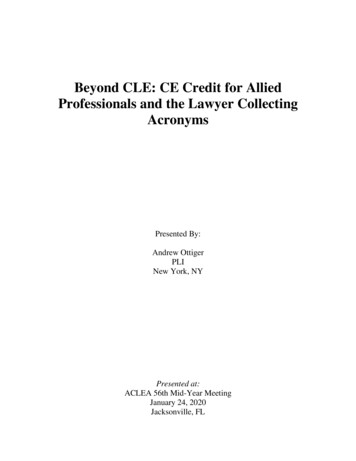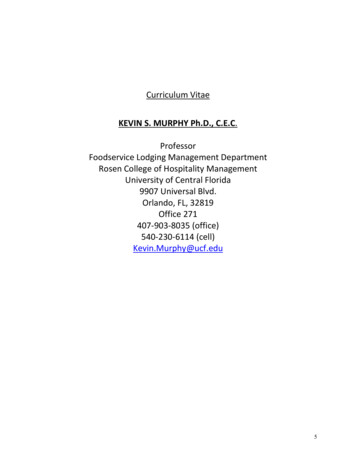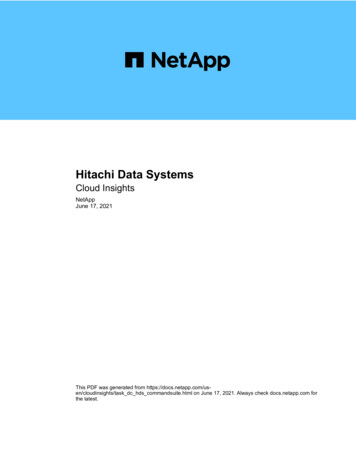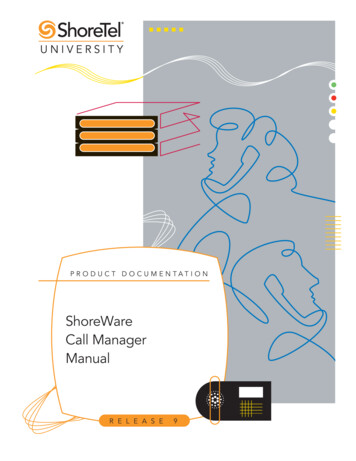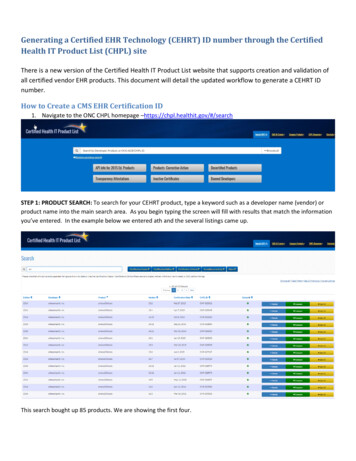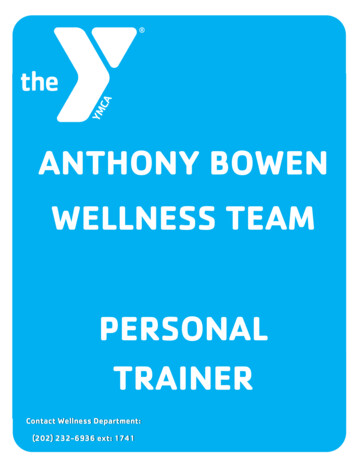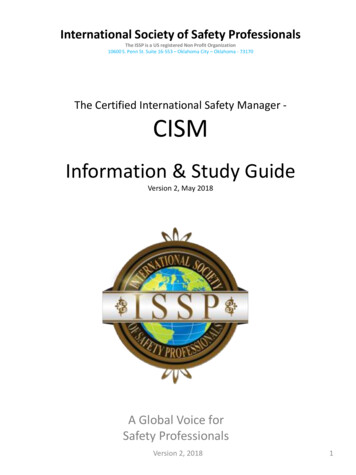
Transcription
International Society of Safety ProfessionalsThe ISSP is a US registered Non Profit Organization10600 S. Penn St. Suite 16-553 – Oklahoma City – Oklahoma - 73170The Certified International Safety Manager -CISMInformation & Study GuideVersion 2, May 2018A Global Voice forSafety ProfessionalsVersion 2, 20181
Recommended reading for every CISM CandidateMeet some of our major contributors and supportersDr. Sidney DekkerGriffith University, Brisbane AustraliaWebsite: https://www.sidneydekker.comJust Culture trailer https://.youtube.com/watch?v z19Qf4MDtQDr. Scott A. Shappell & Dr. Douglas A. WiegmannHFACS Inc.Website: https://www.hfacs.comDr. Tony KernConvergent PerformanceWebsite: https://www.convergentperformance.com
International Society of Safety ProfessionalsThe ISSP is a US registered Non Profit Organization10600 S. Penn St. Suite 16-553 – Oklahoma City – Oklahoma - 73170The Certified International Safety Manager - CISMInformation & Study GuideTable of ContentPart 1About The CISMo Credits & Acknowledgmentso DisclaimerPart 2Steps to obtaining the CISMPart 3CISM FAQ’sPart 3CISM Self AssessmentPart 4Study Guide MaterialPart 5SAMPLE Exam QuestionsVersion 2, 20183
The Certified International Safety Manager -CISMAbout The CISM“The ISSP is dedicated to advancing the profession of safety management. To make that happen,safety professionals – as a community - must seek and obtain professional credentials!”Mr. D Smith, ISSP President, June 2015The ISSP is grateful for the work and publications of the noteworthy safety professionals andauthors listed below. Without them the safety community would lack direction and substance.Although the CISM exam contains only excerpts and philosophy from their publications, we highlyrecommend reading each publication listed in its entirety for continued professional development.Credits and AcknowledgmentsDr. Tony Kern – Blue Threat and Going ProDr. Scott Shappell & Dr. Douglas Wiegmann – Human Factors and Analysis Classification SystemDr. Bill Johnson – Human Factors P.E.A.R. Model, multiple Human Factors publicationsDr. Sidney Dekker – Safety Differently, Just Culture, The Safety AnarchistDr. Erik Hollnagel – Safety I and Safety IIDr. James Reason - Managing The Risk of Organizational AccidentsMr. D Smith – Quantum Safety MetricsPeter M. Senge – The Fifth Discipline, The Art And Practice of The Learning OrganizationMichael E. Porter – What is StrategyCollins & Porras – Building Your Company’s VisionKaplan & Norton – Using The Balance Scorecard As A Strategic Management System, The ExecutionPremiumJeffry M. Hiatt & Timothy J. Creasey – The People Side of ChangePatrick Lencioni – The Five Dysfunctions of A Team, A Leadership FableWest Palm Consulting LLC – How To Write A Business Case For AnythingJeff Sutherland – The Art of Doing Twice The Work In Half The TimeRon C. Mckinnon – Changing The Workplace Safety CultureJoseph A. DeFeo & Joseph M. Juran – The Complete Guide To Performance ExcellenceDr. W.E. Deming – New Economics For Industry, Government EducationA Global Voice forSafety ProfessionalsVersion 2, 20184
The Certified International Safety Manager -CISMAbout The CISMCredits and Acknowledgments - ContinuedDr. Stephen Covey – The Speed Of TrustDr. John C. Maxwell – The 21 Irrefutable Laws of LeadershipTanya M. Anandan – The Shrinking Footprint of Robot SafetyMouloua R. Parasuraman – Automation and Human PerformanceChris Ceplenski – HR Daily AdvisorWayne Vanderhoof – Occupational Health and Safety MagazineMichael Scullin, Julie Bugg, Mark McDaniel, Gilles Einstein – Prospective Memory and AgingDiane Mitchell – Mental WorkloadPhillip Smith – Human-Centered Technologies and Procedures for Future Air TrafficManagementJohn Lee, Katrina A. – Trust in Automation Design for Appropriate RelianceChristopher Janicak – Safety MetricsMary Choy, Rebecca L. Salbu – Jet LagLynn Bard – Human Factor Influencing Workplace SafetyMelissa A. Bailey – Occupational Safety and Health Law HandbookFred A. Manuele – Advancing Safety ManagementPat Clemens, Rodney Simmons – Systems Safety and Risk ManagementMichelle M. Smith – Eight Cultural Imperatives for Workplace SafetyMark Aldridge – History of Workplace Safety in the United StatesLynne Bard – Human Factor Influencing Workplace SafetyThank You to the very talented team of safety professionals that contributed work to thedevelopment of the CISM, your countless hours of hard work, dedication and devotion toadvancing the global safety initiative are greatly appreciated. Because of you our professionwill advance and grow to change the world! Mr. Sonnie Bates, Mr. Scott Beck, Ms. RobinErickson, Mr. Kevin Zemetis, Dr. Terry Taylor, Mr. Nate Predoehl, Mr. Gerold Kosbab, Ms. SharonGrey, Dr. Don Wright, Dr. Gary Helmer, Dr. Curt Lewis, Mr. Dan McCune, Mr. D Smith, Mr. RobertJ. Rendzio, Mrs. Alicia Storey, Mr. Winfred “Mitch” Mitchell, Safety Research Corporation ofAmerica and Keybridge Technologies.A Global Voice forSafety ProfessionalsVersion 2, 20185
The Certified International Safety Manager -CISMAbout The CISMCISM DisclaimerThe International Society of Safety Professionals makes no claim to the competency or ability ofany individual. The ISSP awards the CISM to individuals for verification of safety managementtraining, safety management experience, and successfully passing the CISM exam/test. Noother claims are issued, actual or implied.A Global Voice forSafety ProfessionalsVersion 2, 20186
International Society of Safety ProfessionalsThe ISSP is a US registered Non-Profit Organization10600 S. Penn St. Suite 16-553 – Oklahoma City – Oklahoma - 73170A Global Voice forSafety ProfessionalsAbout the CISMThe Certified International Safety Manager - CISM is an official ISSP certification offered tosafety professionals of all industries and communities of practice.To acquire the CISM a safety professionals must:1) Provide proof of their safety education (digital documents only)2) Provide proof of their safety experience (digital documents only)3) Pass the CISM on-line examination.CISM Prerequisites are: Be a current ISSP member. Provide electronic copies of education and experience or competencies. Pay a 495.00 fee for the exam. (study guide included free of charge) Pass the exam.Benefits of the CISM are:You receive a certificate of certification signed by our Board of Certifying Officials.You receive a CISM glass desk plaque.You receive a CISM lapel pin.Your name and CISM designation displayed on our web siteAn enhanced Safety Professional Credential backed by an international organization.CISM Endorsements – As your safety career progresses you have the option of adding CISMendorsement certifications in specific technical areas of study, such as Human Factors, AccidentInvestigation, etc. or specific industry areas, such as Mining, Aviation, Healthcare, Oil and Gas,etc.Upload your digital documents during the application process on the ISSP web site under theCISM tab.Important Note – when you submit your digital documents include a cover sheet with thecontact information and website of the training organization/s. Also the name, address, officialtitle, and contact information of the management official who attested to you completing thecompetency requirements.To see if you are eligible to become a CISM download the free Information and Study Guidefrom our web site at: www.isspsafety.orgFor questions or additional information please call: (US) 405.694.1644Version 2, 20187
International Society of Safety ProfessionalsThe ISSP is a US registered Non Profit Organization10600 S. Penn St. Suite 16-553 – Oklahoma City – Oklahoma - 73170A Global Voice forSafety ProfessionalsSteps to Obtaining the CISMFollow these steps to obtain and maintain the CISM Certification:Step 1 –Become an ISSP member. Go to www.isspsafety.org and click on the“Join” button.Step 2 -Download and complete the “Self Assessment” worksheet located under theCertified International Safety Manager - CISM menu bar. There are three optionsavailable: Bronze, Silver or Gold. Complete the appropriate fields based onyour individual knowledge and experience level.Step 3 -If your self assessment indicates you meet the requirements, submit yourapplication packet by clicking the “Apply to Become an CISM” option under theCertified International Safety Manager – CISM menu button.Note - The Application packet consists of three things:1. Your completed self assessment2. Certificates or transcripts to prove your training qualifications.3. A letter from management to prove your competency qualifications.Step 4 –Wait to hear via email that your application packet is complete and accepted.Step 5 -Go to web site (www.isspsafety.org) and access the CISM Study Guide and Examunder the CISM menu button. Note - The exam is open book.Step 5 -Utilize the study guide and complete the exam, receive your results immediately,and wait for your certification, desk plaque and lapel pin to arrive in the mail.Step 6 -Begin using the CISM designation in your professional title.Step 7 -Continue to grow your qualifications throughout your career by addingendorsements to your CISM.CISM Endorsements – As your safety career progresses you have the option of adding CISMendorsement certifications in specific technical areas of study, such as Human Factors, AccidentInvestigation, etc. or specific industry areas, such as Mining, Aviation, Healthcare, Oil and Gas,etc.To find out if you are eligible to become a CISM visit us at: www.isspsafety.orgFor questions or additional information please call: (US) 405.694.1644Version 2, 20188
Steps to Obtaining the CISMBecome anISSPmemberSubmityour SelfAssessmentReceive approval toparticipateStudyfor theexamSuccessfullycompletethe examBegin using the CISM Professional Credential &Receive your Certificate, Desk Plaque and Lapel Pin in the mail
The Certified International Safety Manager -CISMFrequently Asked QuestionsFAQ’sIf you have additional questions please go to www.isspsafety.organd use the “contact” function.A Global Voice forSafety ProfessionalsVersion 2, 201810
International Society of SafetyProfessionalsThe ISSP is a US registered Non Profit Organization10600 S. Penn St. Suite 16-553 – Oklahoma City – Oklahoma - 73170 How is the CISM different than other Safety professionalCertifications?1.It’s an internationally recognized certification2.The certification is developed and backed by the ISSP internationalmembership, followers, and partners making it a consensusstandard qualification for safety professionals.3.CISM’s have the ability to grow and advance their certification, astheir career advances by adding additional certifications called“CISM Endorsements” – As your safety career progresses you havethe option of adding CISM endorsement certifications in specifictechnical areas of study, such as Human Factors, AccidentInvestigation, etc. or specific industry areas, such as Mining,Aviation, Healthcare, Oil and Gas, etc. There is no limit as to howmany special or specific endorsements you can obtain. Theendorsements grow with you as your career advances.4.We display your endorsements on our web site as a testament tothe world that you have earned them.Version 2, 201811
International Society of SafetyProfessionalsThe ISSP is a US registered Non Profit Organization10600 S. Penn St. Suite 16-553 – Oklahoma City – Oklahoma - 73170 Who is eligible to become a CISM? Only ISSP members who meet the prerequisites are eligible tobecome a Certified International Safety Manager – CISM. What is the CISM? The Certified International Safety Manager - CISM is a professionalcertification designed to recognize those individuals who haveinvested heavily in their skills, education and experience as apractitioner of safety management. The CISM is built on an industrybest-practice model reflecting the attributes, competencies andexperience necessary to standout in the field as a safetyprofessional. The certification is backed by the standards, verificationand testing provided by the International Society of SafetyProfessionals (ISSP). Why do I need the CISM? For too many years, safety was viewed as a job function instead of aprofession. Proof of an individuals level of achievement as a safetypractitioner was difficult to obtain especially for those who carry ahigh level of responsibility for organizational safety management.Unlike engineering-based safety and reliability analyst roles, thesuccessful organizational safety professional demonstrates a highlevel of competency in multiple domains including; human factors,occupational safety and health, hazard analysis, safety riskmanagement, safety promotion, investigation, safety assurance,safety auditing, business management, communication, training,business acumen and more. Given this diversity it is difficult fororganizations or potential employers to evaluate or validate thequalification of any safety professionals. The CISM certification is thesolution. The CISM allows safety professionals to acclaim theirqualified status and allows organizations to verify it.Version 2, 201812
International Society of SafetyProfessionalsThe ISSP is a US registered Non Profit Organization10600 S. Penn St. Suite 16-553 – Oklahoma City – Oklahoma - 73170 Who controls the CISM? The CISM is developed and managed by the ISSP, a U.S.-registeredNon Profit Organization founded and operated by safetyprofessionals. One fundamental purpose of the ISSP is to promoteand advance the profession of safety management, provide safetymanagement professional development opportunities, provideindustry standards for safety management best practices and tocreate a global, public registry of qualified safety professionals. The ISSP exists is to: Bring enhanced credibility to the profession of safetymanagement. Have a global voice and the ability to shape our profession. Educate the world about the role of the safety professional, theirduties, responsibilities, education, qualification and certificationrequirements, and most importantly, the value safety professionalsbring to an organization. Demonstrate the safety professional value add to organizationsthrough sustained and enhanced profitability. Who recognizes the CISM? The CISM is emerging and quickly becoming a recognizable measureof professionalism and accomplishment that employers, regulators,customers and other stakeholders value in evaluating thecapabilities and qualifications of safety professionals.Version 2, 201813
International Society of SafetyProfessionalsThe ISSP is a US registered Non Profit Organization10600 S. Penn St. Suite 16-553 – Oklahoma City – Oklahoma - 73170 Can I just pay a registration fee and get a CISM designation? NO! The ISSP evaluates the combination of experience, educationand demonstrated competency in those areas deemed critical forsuccessful safety professionals. Experience and education areevaluated against strict ISSP standards. Competency is determinedthrough standardized testing against a published CISM Standard ofKey Knowledge Points. The credibility and success of the CISMprogram is dependent upon its integrity and transparency which ismonitored by the ISSP Board of Directors. What are the CISM eligibility requirements? There are four basic eligibility requirements: Be an ISSP member Meet the training/education requirements (found in the selfassessment) Meet the experience/competency requirements (found in theself-assessment) Pass the CISM exam (on line exam, download free exam studyguide) How do I apply for the CISM certification? CISM application is open to ISSP members in good standing. To apply,visit www.isspsafety.org for ISSP membership and CISM applicationdetails.Version 2, 201814
International Society of SafetyProfessionalsThe ISSP is a US registered Non Profit Organization10600 S. Penn St. Suite 16-553 – Oklahoma City – Oklahoma - 73170 What are the expenses associated with the CISM? The qualification assessment is free of charge. Simply download theeducation and experience requirement documents and self assess.Contact us via the CISM email address for assistance. The exam study guide is free of charge. Download it from our web site. The exam currently cost 495.00 US. Use the study guide to prepare,pay the fee on our web site, and take up to 90 days to complete theexam. When will I know my exam results? The exam is graded automatically upon completion. You will be notifiedimmediately on the website of your score. Please note that you mustscore a minimum of 80% on each section of the exam. You are allowedone additional attempt per body of knowledge. What do I receive for successfully meeting all requirements andpassing the exam? Newly designated CISM receive: A CISM Certificate singed by our Board of Certifying Officials. A tasteful CISM desk plaque with your name engraved. An ISSP Lapel pin Can a ISSP Student Member become a CISM? Yes, as long as she or he meet all the CISM requirements listed in theself assessment tool.Version 2, 201815
The Certified International Safety Manager -CISMSelf AssessmentThis self assessment is design to help you two ways:1.2.Determine if you are ready to become an CISM.Be your check list to obtain the CISM if you are not yet ready.Very Important note – Meet the requirements of page one, “Bronze” level and youare eligible to become a CISM. Silver and Gold levels are optional.A Global Voice forSafety ProfessionalsVersion 2, 201816
International Society of Safety ProfessionalsThe ISSP is a US registered Non Profit Organization10600 S. Penn St. Suite 16-553 – Oklahoma City – Oklahoma - 73170Certified International Safety Manager - CISM Self AssessmentComplete the assessment below to determine if you are prepared to apply for the CISM (Bronze Level).A Global Voice forSafety ProfessionalsImportant Note – Answer yes to all of the questions below and you are eligible to become an CISMI can provide proof of the following safety training or education:Note - Proof means official certificate of training from an established professional safety training organization, or a copy of universitytranscripts. An internal certificate of training from your organization DOES NOT qualify unless your organization is a professional safetytraining organization.Training or education requirements to be eligible for the CISMYesNoList your target goal to complete therequirement if you answered no.Basic Safety Program Management Qualification course, or Safety ProgramManagement education from an accredited University.A course of instruction for Human Factors or Human Error Prevention.A Course of instruction for Auditor QualificationA course of instruction that included Emergency Response Planning in thesyllabus.A course of instruction that included Root Cause Analysis in the syllabus.A course of instruction that included Basic Accident/Incident Investigation in thesyllabus.A course of instruction that included an overview of Basic Principles ofOccupational Safety and Health.A course of instruction that included Safety Risk Management in the syllabus.I can provide proof of the following safety competencies:Note – Proof means a letter signed by a member of management attesting to the fact that you have conducted and completed the tasks.Competency requirements to be eligible for the CISMDraft and revised an organizational safety policy.Designed and conducted a complete safety risk management process.Conducted an organizational Internal Evaluation or safety audit.Lead and conducted an employee safety meeting.Developed an organizational safety training plan.Planned and conducted an organizational Emergency Response exercise.* In addition to the educational and competency requirements you must:* Have a current ISSP Membership.* Successfully pass the CISM Examination.Version 2, 201817
International Society of Safety ProfessionalsThe ISSP is a US registered Non Profit Organization10600 S. Penn St. Suite 16-553 – Oklahoma City – Oklahoma - 73170Certified International Safety Manager - CISM Self AssessmentComplete the assessment below to determine if you are prepared to apply for the CISM (Silver Level).A Global Voice forSafety ProfessionalsImportant Note – Answer yes to all of the questions below and you are eligible to become a Silver Level CISMI can provide proof of the following safety training or education to obtain a CISM Silver Level:Note 1 - Proof means official certificate of training with the course syllabus or course description that includes the required topics or subjectmatter from an established professional safety training organization, or a copy of university transcripts.Note 2 – There is no requirement for an individual to advance to the “Silver” level, it is offered as a career enhancing and professionaldesignation option.Training or education requirements to be eligible for the “Silver” level CISMYesNoList your target goal to complete therequirement if you answered no.Complete the Bronze level requirements plus:A course of instruction that included aspects of Organizational safety Culture.A course of instruction that included management or leadership training.A course of instruction that included Instructor/Facilitator training.A course of instruction that included Business or Safety Administration training.A course of instruction that included Organizational Change Managementtraining.I can provide proof of the following safety competencies:Note – Proof means a letter signed by a member of management attesting to the fact that you have conducted and completed the tasks.Competency requirements to be eligible for the “Silver” level CISMHave a current ISSP membership.Complete the Bronze level requirements.Prepare and administer a safety budget.Conduct an organizational safety culture assessment.Complete an organizational job hazard analysis.Version 2, 201818
International Society of Safety ProfessionalsThe ISSP is a US registered Non Profit Organization10600 S. Penn St. Suite 16-553 – Oklahoma City – Oklahoma - 73170Certified International Safety Manager - CISM Self AssessmentComplete the assessment below to determine if you are prepared to apply for the CISM (Gold Level).A Global Voice forSafety ProfessionalsImportant Note – Answer yes to all of the questions below and you are eligible to become a Gold level CISMI can provide proof of the following safety training or education to obtain a CISM Gold Level:Note 1 - Proof means official certificate of training with the course syllabus or course description that includes the required topics or subjectmatter from an established professional safety training organization, or a copy of university transcripts.Note 2 – There is no requirement for an individual to advance to the “Gold” level, it is offered as a career enhancing and professionaldesignation option.Training or education requirements to be eligible for the “Gold” level CISMYesNoList your target goal to complete therequirement if you answered no.Complete the Silver level requirements plus:Demonstrate at least eight (8) hours of safety professional continuing educationannually.I can provide proof of the following safety competencies:Note – Proof means a letter signed by a member of management attesting to the fact that you have conducted and completed the tasks.Competency requirements to be eligible for the “Gold” level CISMHave a current ISSP membership.Complete the Silver Level CISM requirements.Author a professional safety paper, white paper, safety article, or book and bepublished on a national or international venue. (The ISSP web site qualifies as aninternational venue)Speak on a safety topic at a professional safety forum.Version 2, 201819
The Certified International Safety Manager -CISMStudy GuideBody of Knowledge - BOK“Business Acumen”A Global Voice forSafety ProfessionalsVersion 2, 201820
Key Knowledge PointPeter Senge in the FifthDiscipline states"Team learning starts with, the capacity ofmembers of a team tosuspend assumptions andenter into genuine e,Peter M.(1990), TheFifthDiscipline,Doubleday/Currency,ISBN 0-38526094-6Study Guide MaterialThe discipline of team learning starts with ‘dialogue’, the capacity ofmembers of a team to suspend assumptions and enter into a genuine‘thinking together’. To the Greeks dia-logos meant a free-flowing ofmeaning through a group, allowing the group to discover insights notattainable individually . [It] also involves learning how to recognizethe patterns of interaction in teams that undermine learning. (Senge1990: 10)Version 2, 201821
Key Knowledge PointMichael Porter states: In contrast [tooperational effectiveness], strategicpositioning means performingactivities from rivals’ orperforming similar activities iew’s 10must reads onstrategy.HD30.28.H3952010Study Guide MaterialOperational effectiveness (OE) means performing similar activities better than rivalsperform them. Operational effectiveness includes but is not limited to efficiency. It refersto any number of practices that allow a company to better utilize its inputs by, forexample, reducing defects in products or developing better products faster. In contrast,strategic positioning means performing different activities from rivals’ or performingsimilar activities in different waysMichael E.Porter What IsStrategy?Version 2, 201822
Key Knowledge PointCore ideology, the yin in Collins andPorras scheme, defines what westand for and why we exist. Yin isand complementsyang, the envisioned future. Theenvisioned future is what weto become, to achieve, tocreate—something that will requiresignificant change and progress review’s 10must reads onstrategy.HD30.28.H3952010Study Guide MaterialA well-conceived vision consists of two major components: core ideology and envisionedfuture. (See the exhibit “Articulating a vision.”) Core ideology, the yin in our scheme,defines what we stand for and why we exist. Yin is unchanging and complements yang,the envisioned future. The envisioned future is what we aspire to become, to achieve, tocreate—something that will require significant change and progress to attainCollins andPorrasBuilding YourCompany’sVisionVersion 2, 201823
Key Knowledge PointIn a balanced scorecard framework,a can be viewed asa set of hypotheses about causeand-effect relationships.BOKBusinessAcumenReferenceHarvard businessreview’s 10 must readson strategy.HD30.28.H395 2010Kaplan & NortonUSING THE BALANCEDSCORECARD AS ASTRATEGICMANAGEMENT SYSTEMStudy Guide MaterialThe balanced scorecard supplies three elements that are essential to strategiclearning. First, it articulates the company’s shared vision, defining in clear andoperational terms the results that the company, as a team, is trying to achieve.The scorecard communicates a holistic model that links individual efforts andaccomplishments to business unit objectives. Second, the scorecard supplies theessential strategic feedback system. A business strategy can be viewed as a set ofhypotheses about cause-and-effect relationships. A strategic feedback systemshould be able to test, validate, and modify the hypotheses embedded in abusiness unit’s strategy. By establishing short-term goals, or milestones, withinthe business-planning process, executives are forecasting the relationshipbetween changes in performance drivers and the associated changes in one ormore specified goalsVersion 2, 201824
Key Knowledge PointCEOs or executive leaders are thepreferred senders of messagesrelated to andBOKReferenceStudy Guide MaterialBusinessAcumenChangeManagement:the people sideof changeBased on Prosci's change management research report with 650 participants, Immediatesupervisors are the preferred senders of messages related to personal impact including: How does this impact me? How does this impact our group? How will this change my day-to-day responsibilities?Jeffery M. HiattTimothy J.CreaseyWhen it comes to personal issues, receivers want to hear from someone they know andwork with regularly, namely their supervisor.CEOs or executive leaders are the preferred senders of messages related to businessissues and opportunities including: What are the business reasons for this change? How does this change align with our vision and strategy What are the risks if we don’t change?Version 2, 201825
Key Knowledge Point“The number one obstacle tosuccess for major change projects isand the ineffectivemanagement of the people side ations/Prosci-libraryof-figuresv10.pptStudy Guide Material“The number one obstacle to success for major change projects is employee resistanceand the ineffective management of the people side of change”.Version 2, 201826
Key Knowledge PointProject management ensures yourproject’s solution is designed,developed and delivered, whilechange management ensures yourproject’s solution is tStudy Guide MaterialOrganizational change management is complementary to your project management.Project management ensures your project’s solution is designed, developed anddelivered, while change management ensures your project’s solution is effectivelyembraced, adopted and used.Version 2, 201827
Key Knowledge PointAccording to Patrick Lencioni’s FiveDysfunctions of a Team, the firstdysfunction is:BOKReferenceBusinessAcumenThe FiveDysfunctions ofa Team: aleadershipfableStudy Guide MaterialThe first dysfunction (of a team) is an absence of trust among team members. Essentially,this stems from their unwillingness to be vulnerable within the group. Team memberswho are not genuinely open with one another about their mistakes and weaknessesmake it impossible to build a found
CISM Information & Study Guide Version 2, May 2018 Version 2, 2018 1. Dr. Scott A. Shappell & Dr. Douglas A. Wiegmann HFACS Inc. Website: https://www.hfacs.com . Information & Study Guide Table of Content Part 1 About The CISM o Credits & Acknowledgments o Disclaimer Part 2 Steps to obtaining the CISM Part 3 ISM FAQ [s

